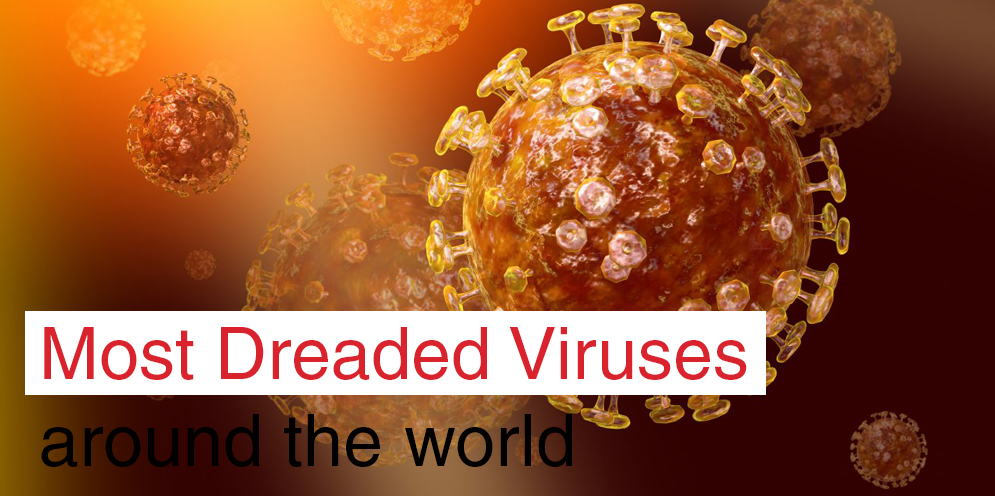The most common viruses afflict people two to three times in their lifetime. But what is a virus? Are virus and bacteria the same thing? With new viruses seeming to break out nowadays, people have good reason to fear them. Read this article to learn about the most dreaded infections worldwide and find out how these diseases spread.
What is a virus?
A virus is a small infectious organism that needs to invade a living cell in order to replicate. They are so small that they are invisible to the naked eye except for the most powerful microscopes. Viruses typically infect one kind of cell. People may get viruses by swallowing or inhaling them, by getting bitten by insects and through sexual contact.
Ebola
This virus has been the subject of one too many headlines in recent years, as thousands of people became infected and governments struggled to handle the situation within their state's and medical science's limitations. The Ebola virus has five strains, all named after various places in Africa. Four out of the five strains cause Ebola hemorrhagic fever, resulting in excessive amounts of blood getting released by the body, sometimes even through the eyes.
How Ebola is transmitted:
- Animal-Animal-Evidence suggests that bats are reservoir hosts of the Ebola virus. They can transmit the virus to other animals they come into contact with such as monkeys, apes, antelopes, even humans.
- Human-Human-The virus can be transmitted when a human comes into contact with the blood or body fluids of a person infected, including the bodies of those who have died of Ebola.
- Spillover Event-A spillover event occurs when an animal gets infected through contact with a reservoir host. Humans can get infected through hunting or preparing the meat of an infected animal before eating.
People get Ebola through direct contact with:
- blood or body fluids of a person sick with Ebola or has died from Ebola. This includes but is not limited to urine, sweat, saliva, feces, breast milk and semen.
- objects such as syringes and needles that have been contaminated with body fluids from a person who is sick with Ebola or the body of a person who has died from Ebola
- infected fruit bats or primates (apes and monkeys)
- contact with semen from a man who has recovered from Ebola e.g. sexual activities
Hepatitis B
Hepatitis B is an inflammation of the liver. It causes jaundice, extreme fatigue, nausea, abdominal pain, yellowing of the skin and eyes and vomiting. It may cause cirrhosis of the liver or liver cancer in later years. An estimated 2 billion people are infected with hepatitis B, with over 350 million that are chronic carriers of the virus. 521,000 die because of this infection every year.
Measles
Measles is a virus transmitted through the air. The virus causes the reddening of the face and trunk, fever, nose running, throat ache, tearing, and white dots in the mouth. There are over 21 strains of the virus to date, with 197,000 dying from measles yearly. Around 200 million people have died from this virus for over 150 years. The number of fatalities due to measles has drastically lowered since the vaccine has been made available.
Influenza
Influenza is a virus that is transmitted through the air. Its symptoms are fever, cough, loss of appetite, fatigue, sore throat, body ache and headaches. It attacks the human respiratory tract. Influenza continues to be a disease that affects many people but is not considered a serious threat unlike in the 20th century when influenza epidemics caused millions of deaths worldwide. Influenza causes 500,000 deaths a year
Pneumonia
Pneumonia can be produced by viruses or bacteria. It causes fever, shiver, sweating, cough, appetite loss, weakness and muscle and head pain. It kills 3.5 million people each year. People who are older than 75, those who are undergoing chemotherapy, asthmatic, alcoholics, and smokers have the highest risk of getting pneumonia. Patients with simple pneumonia can be cured in two to three weeks, but elderly people or those with other debilitating diseases can die of respiratory failure. A vaccine is available that has been proven effective against the most frequent complications.
Shingles
Shingles affects 1 out of 3 people who have had chickenpox. Awareness needs to increase concerning this infection since 95% of adults are at risk of getting infected. This disease afflicts people aged 50 years old and above, but recent cases show that younger people (aged 50 and below) getting infected are on the rise.
Rabies
Rabies is transmitted through the bite of an infected animal, usually dogs. Once bitten, immediate vaccination is required. Otherwise, rabies can be fatal. The viral infection is responsible for 55,000 deaths a year and causes delirium, muscular spasms, breathing difficulties, fits, and the inability to swallow water. Without the vaccine, the virus reaches the brain through the peripheral nerves, incubates, until the patient experiences mania followed by coma then death. Rabies kills 55,000 people worldwide each year.
Dengue
The dengue virus is transmitted through the bites of female Aedes mosquitoes. It affects 50 to 100 million people a year, especially in tropical areas. When bitten by a dengue-carrying mosquito, the patient will experience severe pain during fever. The virus circulates in the blood and aside from fever, causes extreme pain behind the eyes, abdominal pain, nausea, and vomiting of congealed blood or severe diarrhoea. This virus kills 25,000 people yearly.
Marburg Virus
This virus was named after an idyllic town on the River Lahn (Germany), and is deadly as Ebola, with a fatality rate of 90%. It is a hemorrhagic fever virus. It causes convulsions and bleeding of mucous membranes, skin and organs.
AIDS
Approximately 46-60 million people are infected with the human immunodeficiency virus (HIV), which produces AIDS. It is spread through blood, semen, and vaginal fluids. Symptoms start with exhaustion and fever, followed by diarrhea, pneumonia and weight loss. It destroys the body's defenses to any disease or infection. Five persons get infected with HIV every minute, resulting in 3.3 million deaths annually. AIDS is transmitted through the sharing of syringes, unprotected sexual contact and blood transfusions. Antiretrovirals can improve immunity. But because it is too costly, only 4% of patients can receive treatments. There is no vaccine, and the main principle in stopping the disease is the combination of four different drugs. 30 million have died due to AIDS.
How do we protect ourselves against viruses?
Several antiviral drugs are now available, although these medications are more for mitigating the risk and reducing the duration and duration of the disease rather. One, in particular, are Antibiotics that usually kill bacteria, but aren't as effective with viruses. Medical scientists are still working hard on developing antiviral medicine for many viral infections, especially the most fatal ones. At this stage, humans can defend themselves against viruses by maintaining healthy lifestyles and constantly learning about how we can protect ourselves against infections and diseases.








